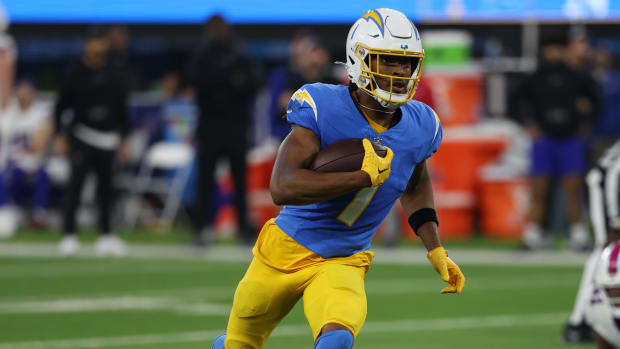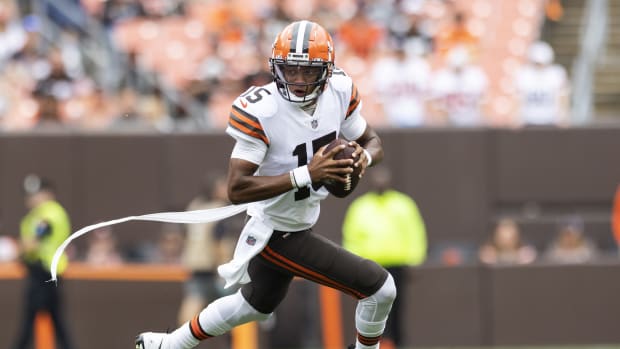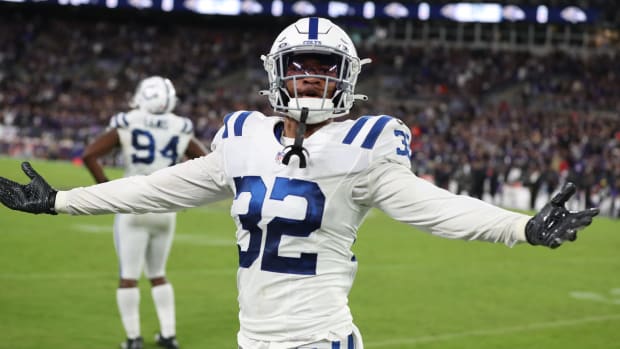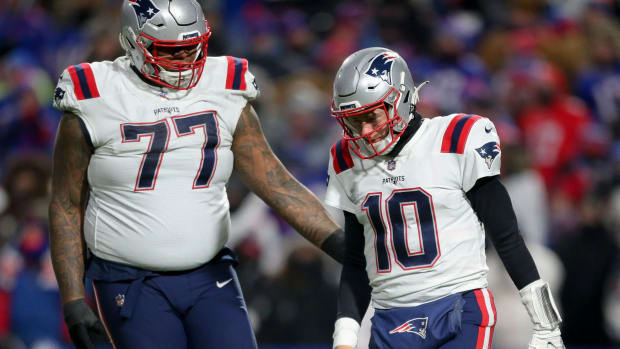So Long, Pete Carroll, the Seahawks Coach and Seattle Institution
To describe Pete Carroll as distinct is understated—remarkably, significantly, comically understated. There’s nothing about Carroll that isn’t distinct. He’s a football coach among thousands of football coaches—and a genre of one.
Let’s start with what it’s like to interview the longtime Seattle Seahawks architect and longtime coach—until Wednesday. The bat phone dings, summoning a journalist to the franchise’s lakefront headquarters. When they arrive, employees escort them to the second-floor coaches’ wing. Carroll’s palatial office sits in the center of a circle of ever-smaller offices; his overlooks both Lake Washington and the practice fields. You can hear it before you see it. In my (somewhat limited) experience, the music is always on, always cranked to or near full volume, speakers always blasting some sort of tune that seems handpicked for the day’s discussion. Carroll is always chomping gum like he wants a few teeth to crack. He’s always smiling, too. But it’s a knowing smile, like he understands what you don’t, like you operate from different planes.
That’s part of what makes Carroll different from other coaches: his separator, an energy, an ethos, a vibe. Carroll was attuned to mental health before most coaches. He developed a process—distinctly his—long before The Process entered any sports’ lexicon. His legacy, while impressive separate of how he shaped it, is not what defines Carroll, nor how he should be remembered. Which is for his embrace of individuality. And for his oh-so human approach to shaping and coaching football teams, whether in college at USC or in the NFL with Seattle or any of his other, briefer stops.

Carroll taught his players, in a league of conformity and a society that can punish its most distinct, to be themselves.
oe Camporeale/USA TODAY Sports
Here’s an example of the complicated vortex presented by the coach everyone calls, much more simply, “Pete.” It’s spring 2015, mere months after Russell Wilson’s interception in Super Bowl XLIX—and the play-call even Carroll’s own locker room disdained—cost Seattle a second consecutive Lombardi Trophy. The dynasty that the core of that team envisioned had already ended. Nobody knew for certain then. So there’s Carroll, in that office, with that music cranking, and rather than run through what happened back in February, he made his mission that day to convince me the franchise would be better off for losing that particular game in that particular way. They’d be strengthened. They’d have clarity. They’d demonstrate grit, resolve.
Now, coaches say stuff like that all the time. It’s easy to dismiss 99 out of 100 of them. But because Carroll is Pete—unabashedly authentic; so optimistic, his glass is full even when empty; someone who believes what they say, even while others roll their eyes—he landed at least in the neighborhood of believable. Like it seemed clear that he believed what he was selling, which mattered far more to the story than what my editors thought he might think. Pollyanna, his mindset, one said. No. Pete.
“He operates like that every moment of every day,” says Ben Malcolmson, Carroll’s longtime assistant/chief of staff until recently. “He’s not just punching at air. He has a concentrated, specific identity—and it’s because he knows who he is.”
With Carroll, that’s impossible, the parsing, climbing into his brain and finding a straight route to what most would think after something like that happened. Many leaders in his locker room wished he had taken more accountability, Marshawn Lynch among them, as he told me this time last year. They wished he had stood before them and did what he asked them to do: take accountability for his mistake. But Carroll doesn’t say things just to say them. He says things to do them, and he couldn’t do what he didn’t feel, deep inside. He didn’t think he had made a mistake. He would make the same decision again.
“It’s been really thrilling to go through this,” he said that afternoon.
He also said: “I know you want to find out—everybody wants to find out, the intrigue, the depth and all that. And how much it hurt. You’ll never know. I can’t make you understand. You pour everything in your life into something and—it goes right, it goes wrong—it’s in you. It becomes part of you. I’m not going to ignore it. I’m going to face it. And when it bubbles up, I’m going to think about it and get on with it. And use it. Use it!”
There’s Pete, right there, one man summarized in a single paragraph fashioned from his own words. And that was Pete, the Seahawks coach and Seattle institution, a man so curious, compelling and original they’ll build a statue for him at the stadium down the road. After news leaked that Carroll would not coach the team again next season, the first without him patrolling the sidelines, working that gum and opponents since 2009, the team announced he would move into a front office role. Malcolmson, when asked whether Carroll might do something other than football, combining all his interests and studies and books read, notes that it had been only a few hours since the news came out, meaning there’s a lot for Carroll to still figure out.
Carroll is 72 years old, although he’d hate to see that number in print. He certainly never defined himself by the ever-higher number of candles on his birthday cakes. In fact, he seemed to relish in debunking his age through action alone, from the games of H-O-R-S-E he led in the locker room, to his early embrace of mental performance, to all the parables, historical anecdotes, long-ago speeches he deployed as motivation to schematic leanings he hardly deviated from, to famous friends such as Will Ferrell, Snoop Dogg, Macklemore he’d call on when his team needed to hear from them. He also, Malcolmson recalls, invoked Michael Jordan, Kobe Bryant and Steph Curry, along with world wars, Native American history, noted authors and the rest.
On what tethered so many disparate methods within the same overall approach, Malcolmson notes that Carroll led with consistency and humanity. He also saw himself as a teacher, first and foremost. “He just continued to love and care for people,” Malcolmson says. “In a variety of special ways.”
Heck, in 2016, I wrote from frigid Minnesota about how Carroll ended the team meeting the night before: By channeling his inner Chancellor (as in, hard-hitting safety Kam) and not only tackling a whiteboard at the hotel but shattering it. I asked Carroll about it. “You know about that?” Arched eyebrow. Knowing smile. Then he just walked away, shaking his head.
Would Lynch have become the linchpin he became, the cornerstone of a near dynasty, without Carroll encouraging Lynch to be as Beast Mode as he wanted, even with the handoff that never happened? No. Would Russell Wilson have flirted with dreams of making the Hall of Fame without Carroll? Wilson’s tenure with the Broncos answers that one.
As someone who lives near the team’s facility, I always laughed when the 12s lamented the Seahawks’ stretch from the Super Bowl loss to now. Newbies, all of them; or, if not, certainly the types of fans who hold the most unrealistic expectations. Sure, Carroll benefited from what Mike Holmgren built in Seattle before Carroll arrived in 2010, after a year of Jim Mora Jr. in between two of the three best coaches in franchise history. When Holmgren took over in 1999, the Seahawks hadn’t been to the playoffs in 10 seasons. They had never won a Super Bowl. Holmgren took them to one, elevated them to respectable; Seattle became a contender to reach the playoffs in most seasons. But he never got back, forcing one change and then another.
It worked, by the way. Carroll’s approach. Wildly, in both college and the pros. Although a disclaimer must be added here. It worked mostly, because there were downsides to Carroll’s unflinching and unapologetically positive approach. Michael Bennett loved Carroll, but he also told me in 2016 that he sometimes read books during team meetings, because he had heard all of the stories more than once; at that point, he knew them all by heart.
Those who considered Carroll too positive, too motivational in nature, always liked to insist that his style of human football coaching fit better in college, where new recruits arrived each season and his vibe of optimism beyond regular optimism had no danger of coming across as stale. His refusal to not do or say what he did not believe ultimately ended the Seahawks era defined by the Legion of Boom just as it was peaking. As we reported last year, players walked out of his meeting after another championship was lost in the first gathering back in Seattle after the Wilson pick changed football history. At least a dozen Seahawks from that time period have told me Pete lost the locker room that day, and, more important, lost the core group of leaders, from Lynch to Richard Sherman, Earl Thomas, Doug Baldwin, Chancellor and the rest.
I’d still argue that Carroll’s true strength—how he operated, from influences to bearing to what separated him from every other football coach—shouldn’t dent his legacy much, if at all. The man was a head coach for 14 seasons in Seattle and 18 in the NFL. In between a short stint with the Jets, followed three more-solid-than-often-credited years with the Patriots, all he did in the decade-plus he spent outside the NFL was build one of college football’s greatest dynasties. Anyone quibbling with that résumé, dynasty or not, handoff or not, whether the Seahawks reached their fullest potential under him or not, is trying too hard.

In Carroll's 14 seasons in Seattle, he reached double-digit wins eight times, won nine games in three other years, and his worst season was 7–9, the mark Seattle twice finished.
Joe Camporeale/USA TODAY Sports
Still, that calculus—what makes Carroll into Pete—also explains what happened Wednesday. The most optimistic 12s might point to Carroll’s recent records and note that in his past two seasons, while moving on from Wilson, Seattle finished 8–9 in each campaign. There’s nothing wrong with that. But when was the last time the Seahawks felt like a team entering the season that had a realistic chance to win the Super Bowl? Probably 2014. Maybe ’15. Maaayyyyyybbeeee ’16. Shaping and coaching rosters with first-round-of-the-playoffs ceilings is stale, by definition. Seattle needs another way and, if Wednesday’s news is true, keeping Carroll around, to still imprint what he can of the ethos he established, makes a ton of sense.
In those 14 seasons, Carroll reached double-digit wins eight times. He won nine games in three other years. His “worst” season was 7–9, the mark Seattle twice finished. He built elite defenses when that wasn’t thought to be possible anymore, not in this passing fancy era of NFL football. He couldn’t win without Wilson … until he did win without Wilson. He couldn’t in Seattle … until he turned the 12s into a pack of rabid, unrealistic die-hards beyond the actual die-hards who stuck with the franchise through everything B.P.—Before Pete.
The Seahawks aren’t what they’ve become without him. That’s obvious. Or should be. But 137 wins in Seattle, two Super Bowl appearances and one championship are not how many—even most—will remember him. Nor how they should. They’ll remember the Carroll who took his shirt off while drafting wide receiver-athletic specimen DK Metcalf, who tackled whiteboards and blasted music and taught them something beyond football that would also help them win games, which is what made his message, his ethos, so powerful in the first place.
He taught them, in a league of conformity and a society that can punish its most distinct, to be themselves.





































